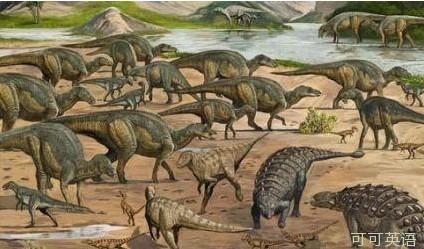
Science and Technology The rise of the dinosaurs Pardon!
科技 恐龍的崛起 恕我直言!
A geological burp may have led to the dinosaurs' domination
地質(zhì)上的甲烷釋放可能是恐龍稱霸地球的原因
THE s, famously, went out with a bang.
眾所周知,恐龍在地球上是突然消失的。
Some 65.5m years ago, at the end of the Cretaceous period, the Earth collided with an asteroid and the biggest terrestrial beasts in history were no more.
大約在6500萬年前的白堊紀(jì)末期,地球與小行星相撞導(dǎo)致最大的陸地獸類全部滅絕。
That left things clear for the rise of the mammals.
此次滅絕事件為哺乳動物的崛起提供了契機(jī)。
But how did the dinosaurs rise to power in the first place?
但首要的是恐龍是如何崛起的呢?
Some light on this question has just been shed by a paper published in Science by Micha Ruhl of Utrecht University, in the Netherlands, and his colleagues.
荷蘭烏得勒支大學(xué)邁克爾·魯爾及其同事在最近一期《科學(xué)》雜志上撰文對此問題進(jìn)行了闡述。
Dinosaurs first appear in the fossil record during the Triassic period, some 230m years ago.
恐龍最早出現(xiàn)在三疊紀(jì)時期(距今約2.3億年)的化石記錄中。
They do not take over, though, until the end of the Triassic, 201m years ago.
但直至三疊紀(jì)末期(距今2.01億年)恐龍才取得地球霸主地位。
That date marks one of five recognised mass extinctions in history (the end of the Cretaceous was another).
歷史公認(rèn)的5次物種大滅絕事件之一就是以三疊紀(jì)末期為標(biāo)志的(另一次發(fā)生在白堊紀(jì)末期)。
In it, half the world's known species disappeared.
在此期間,世界上的半數(shù)已知物種都滅絕了。
Until now, the end of the Triassic has been blamed on massive volcanic eruptions that went on for 600,000 years.
直到現(xiàn)在,人們都一直將三疊紀(jì)的終結(jié)歸因于持續(xù)了60萬年的大規(guī)模火山噴發(fā)。
Dr Ruhl, however, reckons that was not the cause—or, at least, not directly.
然而魯爾博士卻認(rèn)為火山噴發(fā)不是導(dǎo)致三疊紀(jì)終結(jié)的原因或者至少不是直接原因。
By analysing the isotopic composition of hydrocarbon molecules from plant waxes of the period, he found what looks like a spike in the amount of recently non-biological carbon (which has a distinctive ratio of light isotopes to heavy ones), lasting between 10,000 and 20,000 years.
通過分析該時期植物臘的碳?xì)浞肿油凰亟M成,他發(fā)現(xiàn)有種類似最近非生物碳(輕、重同位素有著獨特的比例)的碳元素在數(shù)量上激增,這種現(xiàn)象持續(xù)了1萬到2萬年。
He thinks the liberation of methane stored at the bottom of the ocean in structures called clathrates is the most likely culprit.
他認(rèn)為出現(xiàn)這種現(xiàn)象的最可能誘因是甲烷氣體的釋放,這些甲烷氣體釋放前存儲在海底稱作"籠形包合物"的結(jié)構(gòu)中。
The alternative, that the carbon came from the volcanoes, is unlikely because the spike is much shorter than the period of volcanic activity.
另一種說法是這種碳元素來自于火山,但這不可能,因為碳數(shù)量激增期比火山活動期要短得多。
Methane is a greenhouse gas far stronger than carbon dioxide, so the consequence would have been a rapid warming of the climate—a phenomenon that the rocks suggest did actually happen.
甲烷是一種比二氧化碳濃烈得多的溫室氣體,它的釋放會導(dǎo)致地球氣候迅速升溫——巖石層研究也表明這種現(xiàn)象確實發(fā)生過。
This is not the first time a methane burp has been blamed for an extinction.
人類已經(jīng)不是第一次將物種滅絕歸因于甲烷氣體的脈沖式釋放。
Though the Cretaceous asteroid cleared the stage, mammals did not really get going until 10m years later, in the Eocene epoch.
盡管白堊紀(jì)時期的小行星滅絕了居統(tǒng)治地位的恐龍,但哺乳動物卻一直到1000萬年后的始新世才真正興起繁盛起來。
The preceding Palaeocene epoch was also brought to an end, the rocks suggest, by a sudden release of methane.
巖石層研究表明甲烷的突然釋放導(dǎo)致了之前的古新世時期結(jié)束。
The burp could, of course, have been provoked by the eruptions, so the volcanoes are not off the hook completely.
當(dāng)然甲烷的脈沖式釋放可能是火山噴發(fā)所致,因此火山始終難辭其咎。
But, for those of a nervous disposition, the tying of an ancient greenhouse warming to an ancient mass extinction might suggest lessons for the future.
但是對于這些性情沖動的火山,古代的溫室變暖和古代大量物種滅絕之間的聯(lián)系或許對未來有諸多的借鑒意義。











